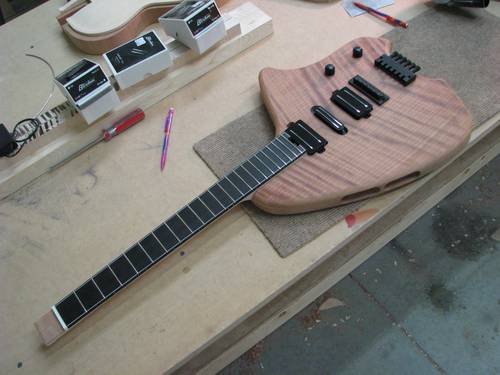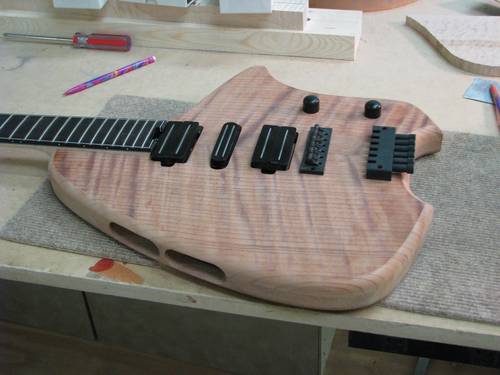Redwood Forshage Electric Guitar
Here’s yet another beautiful electric guitar from builder Chris Forshage. Being built for Mike Friedman, it includes a ported bout and a lovely redwood top.
Mike on his search for the right instrument:
I wanted a guitar like this for some time but did not know where to get one or if anyone would make it. The Klein seemed like a good choice and a number of players whom I admired played them but I have been playing amplified, small bodied acoustics and I wanted a hollow or semi hollow guitar. So to make a long story even longer.. web searches led me to your blog and it was here I learned of Forshage. Great but where to test drive one? I e-mailed Joe Giglio without so much as a common acquaintance or letter of introduction and he most graciously invited me to play his. I cannot relate how much of a kindness he showed to me and my son when we visited him; he is a gentleman and a hell of a player.
And so, Mike ordered himself a Forshage ergo electric guitar which is in its final stages of construction.

Guitar Specs:
- Redwood top and mahogany back guitar body
- H-S-H Barden pickups with Duo Tone humbuckers
- 25″ scale maple neck with ebony fretboard
- ABM headless bridge system
No Sound Holes?
Chris custom builds his guitars and this instrument is no exception. Mike came up with the idea of porting the upper bout rather than go with the traditional sound holes on the front.

Mike on porting the upper bout:
Instead, I thought that instead of a sound hole, why not port the upper bout; I saw something similar on Adrian Legg’s guitar. I noticed some time ago on an acoustic I had with a preamp in the bout that it sounded better to me when the hatch was opened. Some other makers do this too.
Wrap Up
Mike’s very excited about his redwood topped electric guitar and we can look forward to further updates once the instrument is completed. Thanks for sharing Mike!
Chris Forshage does indeed make some very FINE guitars !!!!!!This one’s a BEAUTY!!!!Redwood must be the secret Tonewood of the age …warm beautiful tones, very pleasing to the ear… easy to work, and that figured Redwood is quite beautiful!!!!
We made several guitars out of Giant Sequoia (redwood) Very tight edge grain , rings for a thousand years … Great Tone and very LIGHT weight … the only concern was the softness of the wood which did dent and scratch easily . The softer wood caused a slight loss of sustain, but was compensated for by increasing the density of the neck , the thickness of the neck (old school fat neck)and increasing the mass at the headstock …Best finish for tone was almost none at all …
Hey Rob, nice post. I’ll send more info as it comes my way.
Thanks for stopping in. The final product is going to be amazing…
Very nice guitar!!Pickups it’s very good!!!!Lovely………
Chris is sure turning out some beautiful guitars! It is very nice that each one has something special about it. Congratulations Michael!
Wow, very cool. I thought folks would be interested to know that I have a redwood topped Forshage in the works too. Only mine will be an ergo ACOUSTIC based on Chris’s electric design that we’ve seen so often in these pages. Only a few months to go! Arghh!
I can’t wait to see an acoustic version. 😀
Is Forshage of any Swedish content? Perhaps long back. Family name sounds very Swedish to me. The guitar looks gorgeous! Question:
1. Is the very last fret split in the middle for neck adjustment hole, or is it just an illusion?
Babicz signature guitars – acoustics – has sound holes at the sides too. It’s called personal monitoring! I’ve tried on of those (not Babicz though) and there’s a tremendous difference. You can actually hear your guitar very much louder than if they weren’t there. You can tune your guitar with putting your ear to it, with a lot of background noise, even when a band around you is playing. Some of the models displayed here have “ported soundholes” or Side Sound Ports as they call it.
Babicz Signature Guitars
Check out the picture gallery of the Colossal model.
Babicz Gallery
@Mats – It’s just an illusion. What looks like a split fret is actually just part of the binding you see all the way around the neck.
And thanks for the Babicz links as reference. Interesting stuff. We just need them to make an ergonomic one. 🙂
Tip for later on : Adjust the height of the Bardens so that you can use the rails as high pitched frets!
I do, it’s great! I can get high A and D’s in perfect tune! Throws people off big time sometimes…
I hade tremendous problems with my Bardens until I got it right. Hum and Buzz no matter what I did.
There’s at least SIX wires coming out from each one of them Two/Tones pickups. The soldering is a maze. I noticed on of them wasn’t Two/Tone at all, despite telling so on the tab at the back of the pickup. That’s what threw me off. Got a new one from Barden, and since that time they’ve been Buzz and Hum free. Barden company has been very courteous supportwise, since their resurrection.
Hey Robert, that’s great that your blog was a catalyst for this happening!
@GLW – It’s very exciting to hear that BTEG had a part in connecting folks with guitar builders. It’s not the first time and I expect not the last. As we’ve seen over the last couple of years, there are some wonderful guitar makers out there and folks just need a way to find out about them. I’m glad to help be that conduit. Consider it my contribution to music since, sadly, it won’t be my playing. 😀
Hey,
Just some thoughts on the sound ports. I cannot say how much they might affect the acoustic tone of the guitar. I realize that this is an electric instrument. I just did not like the idea of cutting such a nice top. I’m fairly certain they will direct some acoustic tone and snap to the player’s ear.
A lot of luthiers do port their acoustic guitars and serious debates covering the size and location are common. Also there is much debate as to whether the sound that comes from the ports is sound that is lost inside the guitars body until the port was installed or sound that is diminished from the sound hole’s projection, traditionally in front.
I know that on an acoustic I had that had a modular preamp in the upper bout; it sounded much better to me while playing it with the hatch opened.
Roger, I saw your Forshage demo; it was very informational and helped me with my decision. Looking forward to your acoustic model.
Well, so I’ve heard too. But the contradictory thing is that sound ports has benefits when playing amplified, i e piezo pickup or other systems. Then the sound that’s coming out from the top or front hole doesn’t matter as much, and I’ve heard that side sound ports reduces feedback tendencies as well, due to the weaker acoustic output at the front. What the piezo or pickup system picks up are not that dependent on where any sound port are placed and if overall acoustic volume is reduced. Even on some guitars they use this rubber cover in the sound front hole, in order to reduce acoustic feedback. And I thought that one was for stopping you from dropping the pick inside the guitar… 🙂
Jokes aside…
Then you have acoustic monitoring, and that covers the dreaded piezo tone up a bit. But I agree, it’s subtle and wonder if it really is worth all the debate. You could as well put f-holes up there. On a violin or arch top jazz guitar, f-holes are just for cosmetics and has neglible effects on sound. At least “output” wise.
Actually believe it or not, the way you discovered this, by opening the pre-amp hatch, is what triggered luthiers to incorporate this anyway. Having played such guitars with the hatch open and preamp removed. They got the idea from elctro-acoustics in the first place!
I am not sure the “notch” at the end of the neck is being described correctly. It is actually where Chris puts the truss adjustment access. There is a rotary gizmo much like a Tinkertoy(tm) wheel housed in that cutout area.
@Roger – Thanks for completing the thought. It’s what I meant to include in my reply but that’s what I get for replying on insufficient sleep.
If I’m not mistaken, the adjustment wheel is something like this:
Spoke Wheel Truss Rod Adjustment
OK, Chris (Forshage) needs to quit it! Every new model I see posted here, I think, “Ooh, nice — I want that one, too!” Of course, my “financial advisor” (wife) just gives me the look …
@Robert — you’re right, that truss wheel looks the same as what’s in my Forshage.
Side note on ergo designs: Recently I’ve taken on a few younger students (elementary school), and I’m realizing more how lousy a regular guitar sits, especially for these kids! Since we tend to teach guitar starting with the first position, this happens to be the most difficult reach for them, making it harder to play! So, I’m sitting there with my Forshage thinking, “Gosh, I don’t have a problem reaching the first position. You kids need to buy one of these!”
Well, I asked Chris about building a cheap, student model, but he just laughed. Any entrepreneurs out there???
Ciao,
Marc
@Marc – Thanks for confirmation that I’m not the only one suffering from Gear Acquisition Syndrome aka GAS. My financial advisor has also been keeping a close eye on me. 🙂
Very interesting that you should bring up younger students and how poor guitar designs can hamper learning. I’ve been thinking along the same lines lately and doing some digging around on the subject. Hopefully, there’ll be more to come on this.